Posted October 28, 2019
By ANYI ZHANG
Ira Shapiro, a volunteer tour guide at the Vizcaya Museum and Gardens, takes a look at the people who are ready for the tour, he smiles as he is ready to tell the story about the Vizcaya to them.
“I just love this beautiful place, the architecture and the beautiful decoration. I also enjoy meeting new people and telling them stories about the museum,” said Shapiro.
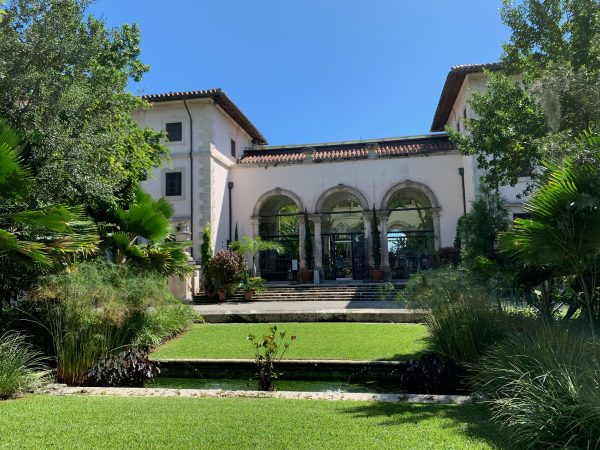
Shapiro has worked at the Vizcaya for over 10 years back in the 1980s, he left for family business and returned three years ago.
Originally built as the private winter home of American businessman James Deering in the early 1900s, Vizcaya is now a National Historic Landmark and an accredited county museum, located in the Coconut Grove area of Miami, overlooking Biscayne Bay. Described as “the finest private house ever built in America” and “a jewel among Miami’s skyscrapers and subdivisions,”
Vizcaya Museum and Gardens was founded by James Deering in 1910, the vice president of his family’s business, and the leading manufacturer in the United States around 1900. In 1908, Deering retired and began planning a winter retreat in Miami to escape Chicago’s cold winters. After several trips to Europe to seek inspiration, Deering teamed up with the design director Paul Chalfin, and the architect F. Burrall Hooffman, designed this beautiful place in the Mediterranean Revival style, with Baroque elements.
The Vizcaya was conceived as a modern and subtropical interpretation of an eighteenth-century Italian villa, in particular the country estates of the Veneto region of northern Italy. The designers adapted traditional Mediterranean architectural styles to the subtropical climate with significant sensibility for environmental consideration. The main area of the house is the Courtyard, the first floor contains several reception rooms, the Library, the music room, and the dining room surround the Courtyard.
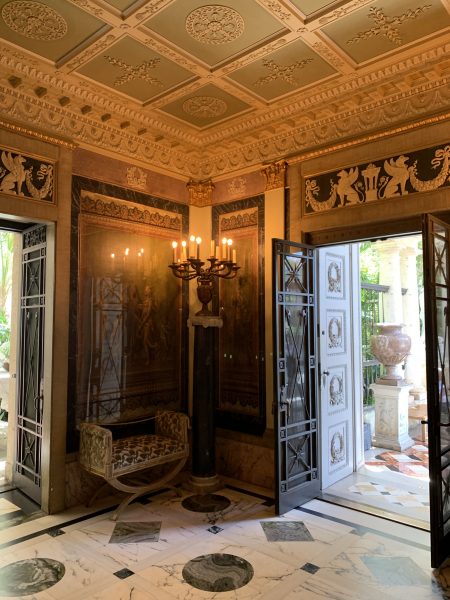
The main house contains antique artworks and furnishings collected in Europe and the U.S., along with items specifically created for Vizcaya. It also features innovative and advanced technologies in the early 1900s.
The second floor contains Deering’s personal suite of rooms and guest bedrooms as well as a breakfast room and the kitchen. The interiors of the Main House were meant to suggest the passing of time, and the layered accumulation of artifacts and memories. The rooms were designed around objects acquired in Italy and assembled into new compositions by Chalfin.
Mary Bethfell, a visitor from West Virginia, cruised from Barcelona with her husband to Miami. She was impressed by the history and decoration and by the beauty of Vizcaya.
“It’s been on my Florida bucket list for a long time. Vizcaya is a feast for the eyes if you appreciate historical architecture, art and gardens. It’s very secluded and away from the hustle of Miami. I loved the amazing breakwater in the form of a sculpted ship in Biscayne Bay at the back of the house,” said Bethfell.
Vizcaya took two years to build during the golden era of the United States in the 1910s. What’s special about the Vizcaya is that, everything is original, they all exist for a reason and they rhyme with each other in Neoclassic style, the Greek style of art that applies simplicity of geometric forms, dramatic use of columns, and a preference for blank walls.
“I enjoy the beauty and history of the museum,” said Santiago Guichon, a visual artist from Uruguay. “I’m also seeking for inspiration for my artwork upon my visit today, this place has great historical value in interior decorations.”
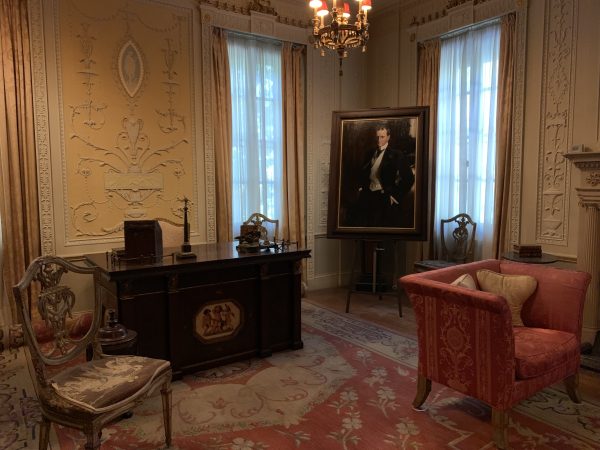
Before entering the museum, visitors are expected to see a small garden full of greens located right in front of the main door, with a few arches surrounded with European designs. Travelers will see two parts of the museum after entering the gate, North Arcade to the left, and South Arcade to the right. The main house contains 34 decorated rooms in total, with a variety of collections including European antiques and paintings.
Step outside, travelers can enjoy the view of Vizcaya’s European-inspired gardens. The center is dominated by low hedges and flowers in a geometric arrangement. Beyond that are the evocative Secret Garden, the intimate Theater Garden, the playful Maze Garden and the once-watery domain of the Fountain Garden with some century-old plants. James Deering took consideration of the humid weather and heat in Miami; therefore, horticultural innovations were common at Vizcaya, including the use of subtropical plants.
Julie Vanghn came all the way from Michigan with her best friend to visit the Vizcaya again.
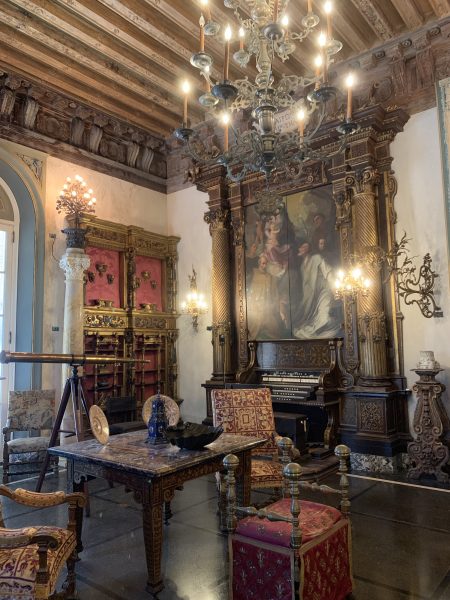
“I had to come back, it felt like it if I was in Europe again. It’s a must see for visitors who have a few days in Miami and want to admire this Italianate mansion. Teleport yourself back to the life of the wealthy industrialists from a hundred year ago,” said Vanghn.
Some employees who work at the Vizcaya chose to come back after years to promote the awareness of the Vizcaya Museum, and to spread the history and story of this amazing historical site. Brad Crandall, a security staff who’s originally from Michigan, chose to work at Vizcaya due to its exotic atmosphere.
“I studied architecture and design in college, I enjoy the history and art at the Vizcaya,” said Crandall, after his surgery, he was looking to find a job that’s less stressful, and at Vizcaya, he overlooks the Biscayne Bay at work, and feels like if he was home.
Kenneth Maya, a Visitor Service associate, has been working at the Vizcaya for almost two years, says weekends are usually busier at Vizcaya, especially in the afternoon.
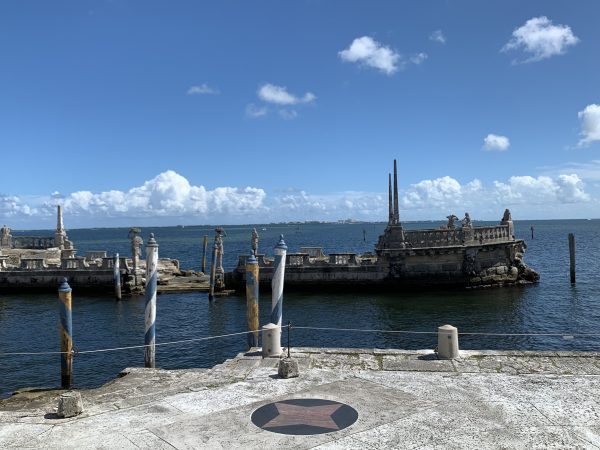
“I love working here, attending visitors while enjoying the peaceful environment here and beautiful architecture. I can’t be happier.” Said Maya.
More than 300,000 people enjoy Vizcaya each year through daytime admissions, educational programs and special events. The Vizcaya Museum and Gardens is still achieving its value to connect with the past, understand the present, and to shape the future.
If You Go
Address: 3251 S. Miami Ave., Miami, FL, 33129
Directions: Vizcaya is located in the north Coconut Grove in Miami, overlooking Biscayne Bay, one mile from downtown Miami and 10 miles from South Miami Beach.
Telephone: 305-250-9133
Website:http://vizcaya.org
Hours: Vizcaya is open Wednesday through Monday from 9:30 a.m. to 4:30 p.m. Closed on Tuesdays, Thanksgiving and Christmas Day. (Monday is usually the best time to go since it’s less crowded)
Admission: $22 for adults (18+), $15 for teens (13-17), $10 for children (6-12), $16 for seniors (65 and older with ID), $15 for college students (with ID), and $10 for visitors with wheelchairs, free for children who are 5 and under, military veterans, and active duty U.S. military personnel only with ID.
Facilities: Vizcaya Café and Shop (located on the north side of the Main House, next to the swimming pool, where visitors can enjoy some food and beverages and shop for souvenir.)
Parking: Vizcaya offers free parking for automobiles. If the main parking lot fills up, parking is available across the street at Vizcaya Village.
Transportation: Metrorail, bus and Uber are available. The Citi Bike has a station located at Vizcaya Museum and Gardens off on South Miami Avenue on SW 32nd Road.
Disabled access: The first floor of Vizcaya’s main house is mostly accessible to visitors using wheelchairs. The center portions of the formal gardens are accessible but visitors should be aware that the paths are primarily dirt and gravel, rather than paved.
Maps and guidebooks: Guidebooks in English are available for purchase for $3 at the ticket booth or café and shop. Maps in various languages are available at no charge at the ticket booth and Main House.
Clothing: Bathing suits and sheer clothing are not permitted. Footwear is also required while walking around the house and gardens.
